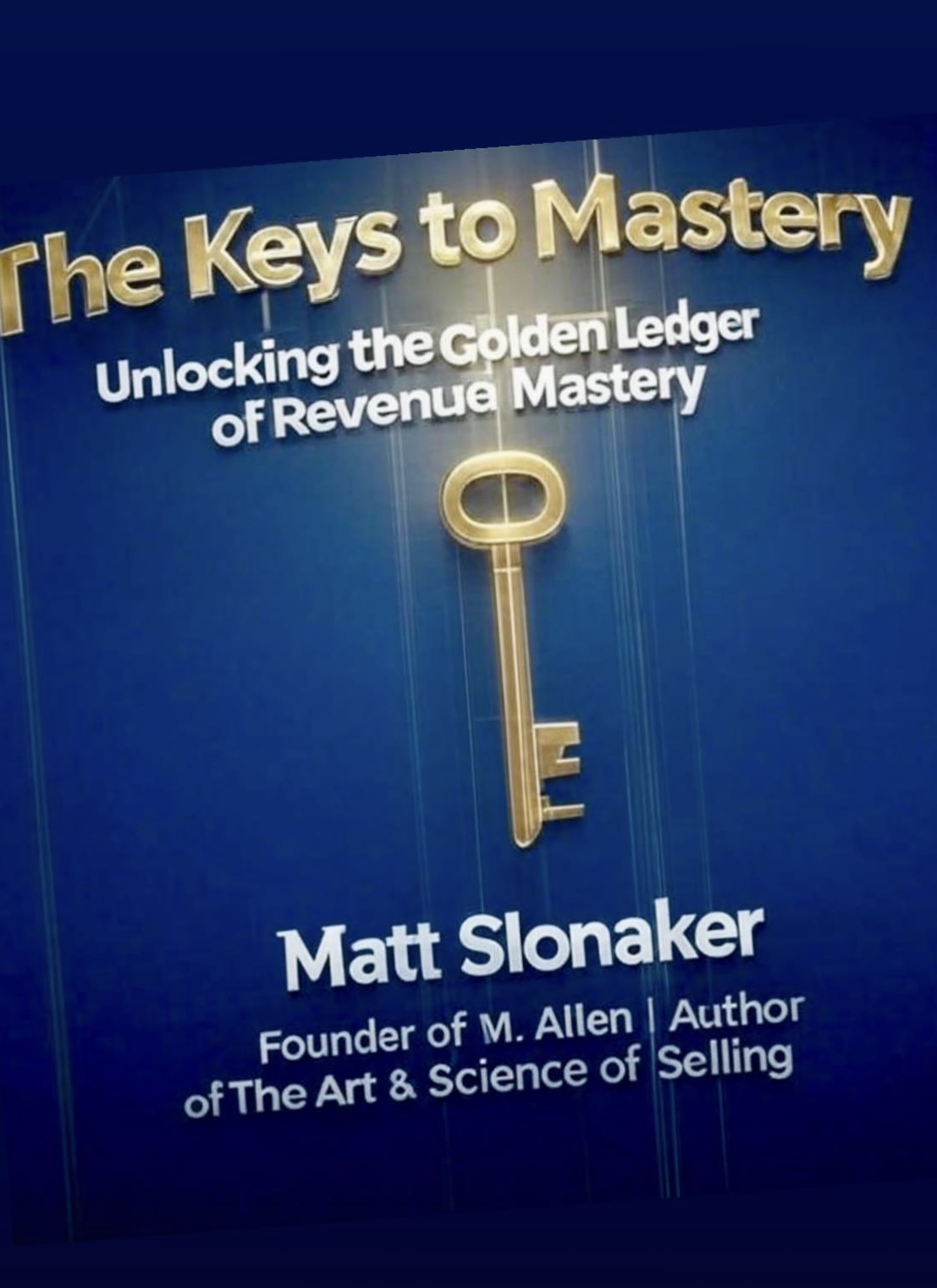An Interview: Matt & Marcus Hale, CEO of FinPulse
Apr 03, 2025
Below is a fictional interview between me, Matt Slonaker, and Marcus Hale, the protagonist of my upcoming book: The Keys to Mastery: Unlocking the Golden Ledger of Revenue Mastery. The questions focus on deal cycles extending, stalled pipeline growth, increasing customer lifetime value, and fostering meaningful C-suite relationships—key themes from my upcoming book.

Interview: Matt Slonaker with Marcus Hale
Date: April 1, 2025
Setting: A virtual fireside chat hosted by M. Allen LLC, ahead of the launch of The Keys to Mastery at matthew-slonaker.mykajabi.com
Matt Slonaker: Welcome, everyone! I’m Matt Slonaker, author of The Art & Science of Selling and the upcoming The Keys to Mastery: Unlocking the Golden Ledger of Revenue Mastery. Today, I’m thrilled to chat with Marcus Hale, the fictional CEO of FinPulse from my new book. Marcus, thanks for joining us from the fintech world of 2025!
Marcus Hale: Thanks, Matt! It’s an honor to share FinPulse’s journey with your audience—especially since it’s all about cracking the code on revenue challenges we’ve all faced.
1. Matt Slonaker: Marcus, let’s dive in. At FinPulse, you hit a wall with deal cycles extending far beyond what you expected. What was driving that, and how did you tackle it?
Marcus Hale: Early in 2025, Matt, our AI lending platform was top-notch, but deals with banks and insurers just wouldn’t close—they’d stretch out, sometimes for months. My CRO, Sarah, nailed it: these institutions were paralyzed by risk aversion to new tech. In Chapter 1 of your book, I learned to see those stalls as a signal, not a dead end. We dug into the data—Chapter 3 stuff—and found they needed faster underwriting and tighter risk models. By tweaking our platform and proving it with pilots, like in Chapter 5, we cut those cycles down. It’s all about diagnosing the bottleneck and acting fast.
2. Matt Slonaker: That ties right into stalled pipeline growth—a pain point for so many revenue leaders. What broke the logjam for FinPulse?
Marcus Hale: Stalled pipelines were killing us—leads piled up, but nothing moved. Chapter 2 was a game-changer: my mentor, Solon, showed me our silos were the culprit—sales, product, and marketing all pulling in different directions. We unified them around a ‘GTM Mastery’ blueprint—Insight, Precision, Scale—and suddenly, the engine started humming. By Chapter 8, we had a synchronized machine: product innovating, marketing pushing ROI-focused campaigns, and sales closing. That seven-figure bank deal? It wouldn’t have happened without breaking those silos.
3. Matt Slonaker: Love that alignment focus. Now, how did you approach increasing customer lifetime value at FinPulse? It’s a hot topic for CROs today.
Marcus Hale: Customer lifetime value became our north star, Matt, especially by Chapter 11—‘The Vault of Results.’ Revenue’s great, but I realized renewals and referrals were the real gold. We used servicing diagnostics to boost client ROI—think 30% faster underwriting—and shared those wins with them. One bank tripled its contract because we proved our impact. It’s about shifting from a sale to a partnership, like Chapter 6 taught me with multi-channel engagement. When clients see you’re in it for their success, they stick around and bring others along.
4. Matt Slonaker: That’s a powerful shift. Speaking of partnerships, fostering meaningful C-suite relationships can be tough, especially in risk-averse sectors. What challenges did you face there?
Marcus Hale: Oh, the C-suite was a fortress—Chapter 5 calls it ‘The Bridge of Credibility’ for a reason. CFOs obsessed over costs, CROs over risks, and they’d grill us on security and integration. The challenge was cutting through their skepticism—they saw us as just another vendor. I learned in Chapter 4 to ditch generic pitches and hit their pain points with targeted messaging, like ‘30% faster processes, measurable gains.’ Building trust was brutal but essential.
5. Matt Slonaker: So, how did you turn that skepticism into trust with those C-suite execs?
Marcus Hale: It took evidence and patience, Matt. In Chapter 5, we rolled out case studies—real data showing that 30% underwriting boost—and tailored pilots to prove we could fit their systems without chaos. When the bank’s CIO said, ‘You’ve addressed our concerns,’ I knew we’d crossed the bridge. Chapter 6 amplified that with webinars and whitepapers, positioning us as thought leaders. It’s about showing you’re a strategic ally, not a sales pitch—something your readers will see play out step-by-step.
6. Matt Slonaker: Brilliant. Let’s talk competition—deal cycles and pipelines often stall when rivals undercut you. How did you handle that storm?
Marcus Hale: Chapter 10—‘The Storm of Rivals’—was intense. Competitors slashed prices, and the pressure was on to follow suit. But I said no—we doubled down on value. We refined our AI for unmatched accuracy and upped our service game, like in Chapter 11. Marketing blasted out success stories, not discounts. When a marquee client chose us over a cheaper rival, it proved the lesson: differentiation beats a race to the bottom. Your book really drives that home—value keeps the pipeline flowing.
7. Matt Slonaker: Scaling that kind of success is another beast. How did you extend those wins without losing momentum?
Marcus Hale: Scaling was Chapter 9—‘The Skyline of Scale.’ We’d cracked banks, but insurers were next, and I knew reckless growth could tank us. We hired specialists—AI pros, sales aces—and beefed up our tech stack, all while keeping our core stable. Data guided us, like Chapter 3’s insights, to balance ambition with execution. Landing that second enterprise deal—an insurer—showed me deliberate scale keeps deal cycles tight and pipelines growing. It’s a blueprint your readers can run with.
8. Matt Slonaker: Last one, Marcus. What’s the big takeaway from your journey that ties all this together for revenue leaders?
Marcus Hale: It’s the Golden Ledger mindset, Matt—from Chapter 1 to the Epilogue. Deal cycles, pipelines, customer value, C-suite trust—they all hinge on discipline and alignment. You’ve got to diagnose fast, unify your team, prove your worth, and scale smart. By Chapter 12, I was sharing this at a summit, handing it off to my team to carry forward. It’s not a myth—it’s a framework. Your book lays it out: revenue mastery isn’t luck; it’s a system you build and lead.
Matt Slonaker (Summary): Wow, Marcus, you’ve just given us a masterclass in revenue leadership—and a sneak peek into The Keys to Mastery. Let’s recap the gold here. First, extended deal cycles? Marcus tackled them by diagnosing bottlenecks with data and proving value through pilots—straight out of Chapters 1 and 5. Stalled pipeline growth? He broke silos and synced his team, a Chapter 2 and 8 playbook that landed seven-figure wins. Increasing customer lifetime value? Chapter 11’s focus on client ROI turned contracts into partnerships, driving renewals and referrals. And those C-suite relationships? Chapters 4 and 5 show how targeted messaging and credibility—case studies, pilots—turned skeptics into allies. Marcus weathered competition with value over price (Chapter 10) and scaled deliberately (Chapter 9), all tied together by the Golden Ledger framework—a mindset of disciplined execution. That’s what this book’s about: transforming real-world challenges into revenue triumphs.
Pre-order it at matthew-slonaker.mykajabi.com, and let’s unlock your mastery together. Thanks, Marcus, and thanks, everyone, for joining us!

